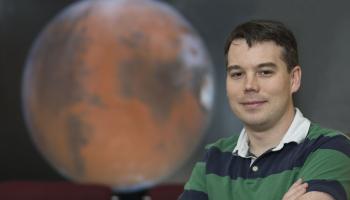UVA Astrochemist Helps Explore the Chemistry of Outer Space

Astronomers have been seeking to identify new molecules in space for more than five decades, a search that has led to date to the discovery of 276 specific molecule types. The latest discovery comes from an international collaboration including the contributions of a University of Virginia associate professor of chemistry and astronomy and his research group.

UVA astrochemist Rob Garrod’s research group provided the theoretical and modeling analysis to identify a new molecule in space. (Photo by Molly Angevine / Arts & Sciences)
Associate professor Rob Garrod’s lab provided the theoretical and chemical modeling analysis in a collaboration with astrophysicists from the Max Planck Institute for Radio Astronomy in Bonn, Germany, reporting the first identification of the molecule iso-propanol in interstellar space. Well known for its use as a hand sanitizer, iso-propanol is the largest alcohol detected so far, demonstrating the increasing complexity of one of the most abundant classes of molecule found in space. The discovery is being published online this week in a European astronomy journal, Astronomy & Astrophysics.
Researchers have sought to understand how organic molecules form in interstellar space – in particular in regions where new stars are born – and how complex these molecules can be. Discoveries of iso-propanol and other molecules are helping those researchers establish connections to the chemical composition of comets and other bodies in the solar system.
“We’re discovering molecules that are more and more complicated at the very early stages of star formation,” Garrod said. “Increasingly, we’re looking at a situation where life is potentially being given a head start by the chemistry happening very early on in space, before even a planet is formed.”
The team’s identification of iso-propanol in space was made possible through observations of a particular star-forming region in our galaxy where many molecules have already been detected. Sagittarius B2 is located close to the center of our galaxy and is the target of an extended investigation of its chemical composition with the Atacama Large Millimeter/submillimeter Array telescope in Chile. Microwave-wavelength emission from molecules floating around in Sgr B2 provides spectral patterns that can be recognized back on Earth, but these patterns can be weak and difficult to distinguish from each other. ALMA’s introduction 10 years ago has made it possible to go beyond what could be achieved with earlier, single-dish telescope technology.
So far, the team’s ALMA observations have led to the identification of three new organic molecules (iso-propyl cyanide, N-methylformamide, urea) since 2014. The ALMA project’s latest result is now the detection of propanol (C3H7OH).
“Our group began to investigate the chemical composition of Sgr B2 more than 15 years ago,” said Arnaud Belloche from the Max Planck Institute for Radio Astronomy, the lead author of the detection paper. “These observations were successful and led in particular to the first interstellar detection of several organic molecules, among many other results.”
Propanol is an alcohol and is the largest in this class of molecule to be detected in interstellar space. It exists in two forms (“isomers”), depending on which carbon atom the hydroxyl functional group is attached to: 1) normal propanol, with OH bound to a terminal carbon atom of the chain, and 2) iso-propanol, with the hydroxyl bound to the central carbon atom in the chain. Both isomers of propanol in Sgr B2 were identified in the team’s ALMA data set; the first interstellar detection of normal propanol was obtained shortly before the ALMA detection by a Spanish research team with single-dish radio telescopes in a molecular cloud not far from Sgr B2. The detection of iso-propanol toward Sgr B2, however, was only possible with ALMA.
This research is part of a long-standing effort to probe the chemical composition of sites in Sgr B2 where new stars are being formed and understand the chemical processes at work during star formation. The goal is to determine the chemical composition of the star-forming sites, and possibly identify new interstellar molecules. Many of these molecules are formed on the surfaces of microscopic dust grains, where they remain until dust temperatures are high enough to release them.
“The star formation process is associated not just with forming very complex molecules, but it’s also important for heating them up, releasing them from the dust grains and into the gas phase where we can actually detect them,” Garrod explained. “Our theory group at UVA produces computational models of all of that solid phase and gas phase chemistry, including the release of those molecules into the gas, in order to explain the actual abundances we detect with the radio telescopes.”
Detecting closely related molecules that slightly differ in their structure (such as normal and iso-propanol or, as was done in the past: normal and iso-propyl cyanide) and measuring their abundance ratio allows the researchers to probe specific parts of the chemical reaction network that leads to their production in the interstellar medium.
“The detection of both isomers of propanol is uniquely powerful in determining the formation mechanism of each. Because they resemble each other so much, they behave physically in very similar ways, meaning that the two molecules should be present in the same places at the same times,” Garrod said. “The only open question is the exact amounts that are present; this makes their interstellar ratio far more precise than would be the case for other pairs of molecules. It also means that our theoretical chemical network can be tuned much more carefully to determine the mechanisms by which they form.”
“There are still many unidentified spectral lines in the ALMA spectrum of Sgr B2, which means that still a lot of work is left to decipher its chemical composition,” added Karl Menten, Max Planck Institute for Radio Astronomy director and the head of its Millimeter and Submillimeter Astronomy research department, and a member of the team that made the discovery. “In the near future, the expansion of the ALMA instrumentation down to lower frequencies will likely help us to reduce the spectral confusion even further and possibly allow the identification of additional organic molecules in this spectacular source.”









